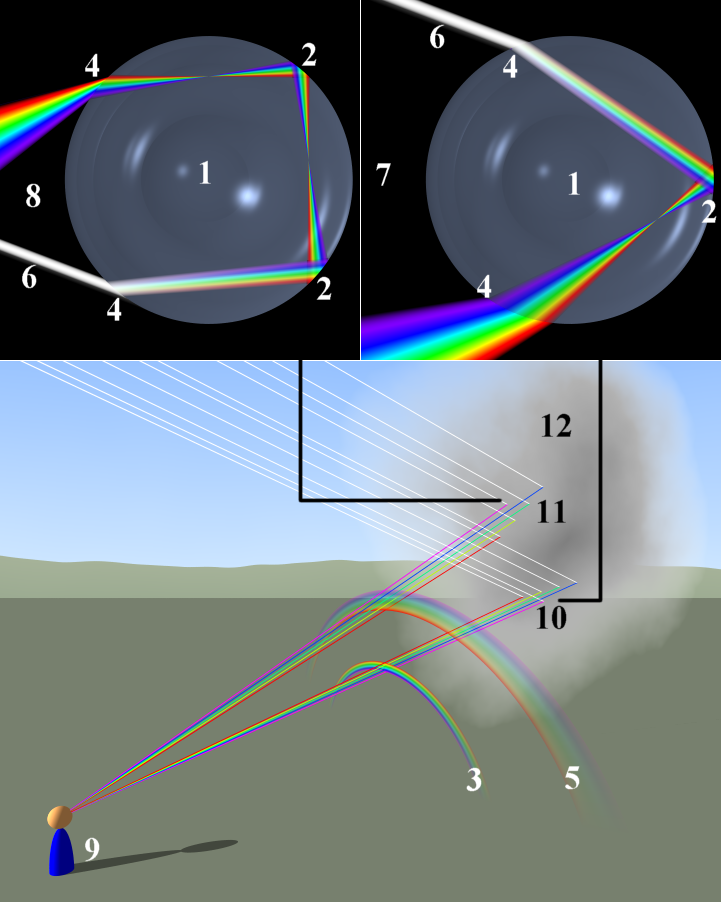
Rainbow appears due to dispersion of sunlight by __________.
(A) Water droplets
(B) Prism
(C) Glass Block
(D) All
Answer
180k+ views
Hint To find the correct answer, you firstly need to know that rainbow is a naturally occurring phenomenon and why and how it is produced. Also, as the name suggests, rainbow has a close correlation with the rain as rainbow is produced after the rain has stopped and there is still moisture in the air.
Complete step by step answer
As mentioned in the hint section of the solution, to solve the question, you first need to have a basic understanding about the rainbow. Let us share some information about rainbow first:
Rainbows are formed by a combination of refraction and reflection. You may have noticed that you see a rainbow only when you look away from the sun. It is so as the light from the sun enters a drop of water and is reflected from the back of the drop, as shown in the image. This is the only time when reflection happens in the whole process. As for refraction of the sunlight, the light rays from the sun are refracted both as they enter and as they leave the drop. Since the index of refraction of water varies with wavelength, the light is dispersed, and a rainbow is observed. Keep in mind that there is no dispersion caused by reflection at the back surface, since the law of reflection does not depend on wavelength. The actual rainbow of colors seen by an observer depends on the myriad of rays being refracted and reflected toward the observer’s eyes from numerous drops of water.

As we have described about the rainbow, it must be clear that the rainbow appears due to the dispersion of sunlight by water droplets that are present in the air due to the rain.
Hence, the correct option is option (A).
Note It should be noted that even though the VIBGYOR effect of white light or sun rays can be observed in a lab through the help of a prism, it would not be considered a rainbow since rainbow is a naturally occurring phenomenon and only the one due to the dispersion of light rays from water droplets is referred to as the rainbow.
Complete step by step answer
As mentioned in the hint section of the solution, to solve the question, you first need to have a basic understanding about the rainbow. Let us share some information about rainbow first:
Rainbows are formed by a combination of refraction and reflection. You may have noticed that you see a rainbow only when you look away from the sun. It is so as the light from the sun enters a drop of water and is reflected from the back of the drop, as shown in the image. This is the only time when reflection happens in the whole process. As for refraction of the sunlight, the light rays from the sun are refracted both as they enter and as they leave the drop. Since the index of refraction of water varies with wavelength, the light is dispersed, and a rainbow is observed. Keep in mind that there is no dispersion caused by reflection at the back surface, since the law of reflection does not depend on wavelength. The actual rainbow of colors seen by an observer depends on the myriad of rays being refracted and reflected toward the observer’s eyes from numerous drops of water.

As we have described about the rainbow, it must be clear that the rainbow appears due to the dispersion of sunlight by water droplets that are present in the air due to the rain.
Hence, the correct option is option (A).
Note It should be noted that even though the VIBGYOR effect of white light or sun rays can be observed in a lab through the help of a prism, it would not be considered a rainbow since rainbow is a naturally occurring phenomenon and only the one due to the dispersion of light rays from water droplets is referred to as the rainbow.
Recently Updated Pages
Class 11 JEE Main Physics Mock Test - FREE Online Mock Test Series 2025

Degree of Dissociation Important Concepts and Tips for JEE

Learn Conversion of Galvanometer into Ammeter and Voltmeter for JEE Main

JEE Main Chemistry Question Paper PDF Download with Answer Key

Electric Field Due To Uniformly Charged Ring - JEE Main 2025

JEE Electricity and Magnetism Important Concepts and Tips for Exam Preparation

Trending doubts
JEE Main 2025 Session 2: Application Form (Out), Exam Dates (Released), Eligibility, & More

JEE Main 2025: Derivation of Equation of Trajectory in Physics

Displacement-Time Graph and Velocity-Time Graph for JEE

Atomic Structure - Electrons, Protons, Neutrons and Atomic Models

Learn About Angle Of Deviation In Prism: JEE Main Physics 2025

What is Hybridisation in Chemistry?

Other Pages
NCERT Solutions For Class 11 Physics Chapter 2 Motion In A Straight Line - 2025-26

NCERT Solutions For Class 11 Physics Chapter 1 Units and Measurements - 2025-26

NCERT Solutions For Class 11 Physics Chapter 3 Motion In A Plane - 2025-26

JEE Advanced Marks vs Ranks 2025: Understanding Category-wise Qualifying Marks and Previous Year Cut-offs

Units And Measurements Class 11 Physics Chapter 1 CBSE Notes - 2025-26

Motion in a Straight Line Class 11 Physics Chapter 2 CBSE Notes - 2025-26




